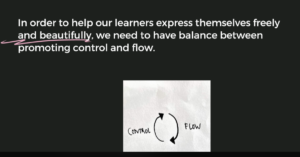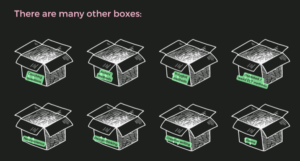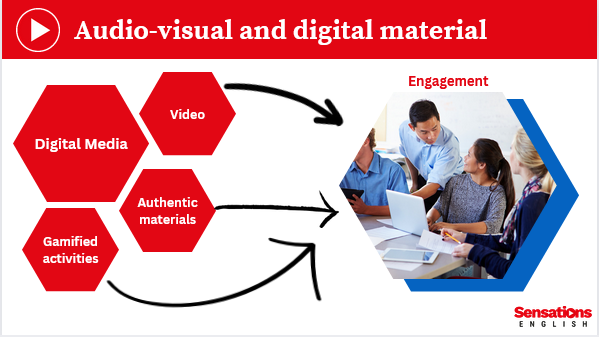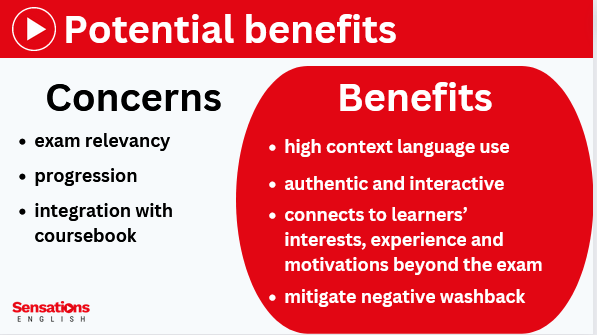English is an international language: us ELTABBers and our learners come from all corners of the map. But we all live and work together in our little Berlin -Brandenburg box.
ELTABB Chair and Journal Editor Sandra Roggenkamp visited Brighton for the IATEFL yearly conference, to help us all think a little more outside-the-box.
This year’s IATEFL Conference was enjoyable and rewarding in many ways – from a plethora of inspiring presentations and fresh teaching perspectives to networking and socialising with colleagues and friends, all against the backdrop of a charming beach silhouette. Here are some of my personal highlights and takeaways.

IATEFL Associates’ Day
I started off the week with the IATEFL Associates’ Day, a pre-conference meeting of representatives of associate members from across the globe (of which ELTABB is one). There were representatives from countries such as Spain, Israel, Panama, Belgium, Palestine, Bangladesh…
Once again, Germany was very well-represented, due to its many regional ELTAs. It was nice making new connections while also seeing some familiar faces from HELTA (Hamburg), ELTA-Rhine and MELTA (Munich).
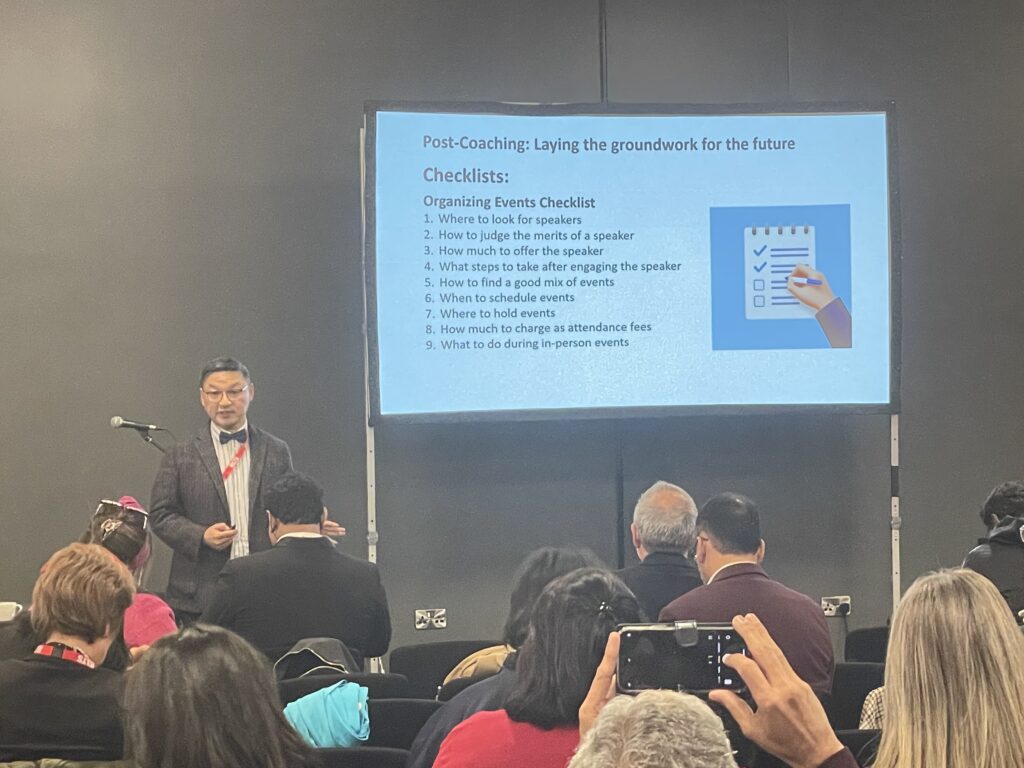
We spent the day listening to presentations on ESL-related topics and doing group work on specific questions, such as finding effective strategies to increase and measure the visibility of teachers’ associations. After brainstorming and discussing ideas within our own groups (all composed of people coming from different corners of the world) we presented our results in the plenary.
Jean Theuma from the IATEFL Associates Committee did an excellent job leading us all through the day, providing the structure and reminding presenters to “keep it precise and keep it moving” to avoid listener fatigue.
To mix things up, there were poster presentations during the breaks, and my personal highlight was giving a presentation on my chosen topic of brain-friendly learning.
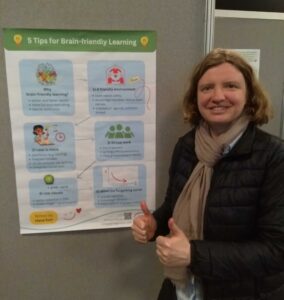
If you’re interested in the subject, you can download my poster here.
We rounded off the day with a reception at the bar of the conference’s Skyline room, enjoying the beach view and catching up with other attendees over a cool drink.
IATEFL Presentations
Over the next few days, I attended a number of presentations on different ELT-related topics. Here’s an overview of my favourite talks.
1. Sarah Plochl: “English for artists – between ESP, self-expression and control”
Sarah’s workshop on teaching English to artists was engaging and interactive. What’s more, it was surprisingly relevant, as it turned out that the challenges artists face are similar to the issues a lot of other learners experience.
She pointed out that, like any language learner, artists seek to make sense of the world, express themselves and share their perspectives for other people to (hopefully) understand.
Also, like other learners, artists constantly oscillate between “control” and “flow”.
While they aim to be precise, they also want to expresss themselves freely. Thus, “control” and “flow” are two sides of the same coin: you need control and precision to express yourself “freely and beautifully”.
Of course, lots of teachers focus mostly on flow, helping students get their point across, even if it’s not done very elegantly. But whether you’re a business person who wants to hold captivating presentations or an artist aiming to inspire, your language will need both thoughtfulness and creativity…
A positive mindset: know what you know and take it easy
Sarah went on to explain that in her work with artists, she focusses on cultivating a positive mindset and confidence. As most artists are perfectionists, they tend to ignore what they already know and underestimate their capabilities. So a good starting point is to show them what they already know with the help of brief exercises and conversations.
Sarah also uses simple drawings to explain things and to create a sense of relaxed imperfection. By sharing “crappy doodles”, she creates a welcoming space in which it’s okay not to be perfect.

Another issue for many artists is that they feel like they are “showing off” when they talk, write about or present their work to others. This is something they share with many other learners of English, especially introverts. Sarah thus helps them realise that they help and inspire others when they present their work, and that their clients are grateful to them for that.
She then presented four case studies about different clients with individual challenges (e.g talking, presenting or writing about their work). She divided us into four groups and assigned each group a case study. We then developed strategies for helping the respective client improve their language skills.
A case study
My group considered how to help a sculptor talk and write about her work. She had a B2-level of English but would often let her partner talk on her behalf in international contexts.
Our main idea was confidence-building through establishing the specific vocabulary she needed to speak about her work. We suggested that she also write scripts and practise speaking while recording herself to simulate getting “out there” and making herself visible.
Sarah added that she would start by showing the student how much knowledge she already possessed, and that she was perfectly able to speak for herself without relying on her partner. She also shared a funny anecdote about a student who needed specific vocabulary to talk about their work, and it turned out the most appropriate expression was the word “thingy”.
Mix and match – fresh teaching ideas
Besides, Sarah encouraged us to “think outside the ELT box” to include more techniques, such as creative writing, design thinking, and even dancing – or to incorporate somewhat dated but fun and effective teaching methods such as Dictogloss.
Another tip she gave us was to help students get English out of the classroom and into their lives. An easy way for learners to do this is switching their phone settings and apps to English, for example.
My takeout from this talk was that it’s fine to use students’ feelings of perceived inadequacy as a starting point and take it from there, gradually building up confidence and skills – with the help of both conventional and creative methods.
2. Gerald Smith: “Engaging and effective exam preparation using audio-visual and digital resources”
This presentation on using digital materials for exam preparation was light-hearted and breezy. Gerald, who’d just had a less-than-civil encounter with a local seagull, kicked off his talk with a casual poop joke.

He then explained that exams tend to have a “washback” effect, meaning that previous bad results can cause exam nerves, shame, guilt and generally low motivation. So any type of exam preparation should try to counterbalance this.
But why would digital materials be more effective than coursebooks then?
Some of the reasons Gerald mentioned were:
- synchronicity: there is an abundance of digital materials that are timely and relevant, which is generally more motivating than using coursebooks dating back a couple of years
- real-world situations: students respond better to authentic materials (e.g. street interviews or news), which are easy to find online
- topics: digital materials allow the teacher to take students’ interests into account (could be anything from hobbies to politics)
- high video literacy: learners are already used to watching videos and quickly grasping visual content, so it’s a “home advantage”
- audio-visual materials are multi-sensory and often contain moving images that make them more engaging
- authentic digital materials contain frequently used language
An example: using videos in the classroom
Gerald provided an example of how digital materials can be used to practise speaking. He picked a short video on art murals in crisis-ridden Baghdad, accompanied by questions and tasks.
The questions can be general (e.g. “What was the topic about?”) or more specific (“Who made the project and why?”) or personal (“Do you like it? Why/why not?”).
They can also be used to simulate exams or interviews, with one student being a test taker/interviewee and the other one an examiner/interviewer (there can be more roles – such as note taker or moderator – depending on group size).
Gerald added that it’s good to pick a topic that’s not only interesting but also a bit polarising, because if students have an opinion on something, they will naturally want to speak about it.
But what about coursebooks and exam relevancy?
He went on to explain that teachers may have reservations about exam relevancy and coursebook integration. Here’s an overview of the concerns and benefits when it comes to using digital materials:
While the pros obviously outweigh the cons, in order to ensure the exam relevancy of the digital materials in use, Gerald’s recommendation was to focus on:
- fostering Higher Order Thinking Skills
- building contextual language awareness
- developing lexical storage
- promoting learner autonomy
The idea here is that successful integration means helping students develop practical, transferable skills that will help them prepare for the exam, but at the same time go beyond exam preparation. If students can learn to recognise recurring patterns, improve their communication skills and develop lasting motivation, they’ll be able to apply their skills and knowledge in any given context. This will mitigate the “washback” effect and prepare them for real-world encounters.
I left Gerald’s presentation with a wider perspective on what it means to learn successfully and sustainably by shifting the focus from “exam-centred” to “student-centred”.
3. Sheila Thorn: “Designing listening and language practice materials to accompany authentic recordings”
This was Sheila Thorn’s farewell talk – after 25 years of speaking at IATEFL – and her witty, authentic delivery definitely did it justice.
The issue she addressed in her presentation was the mismatch between coursebooks and authentic language and how this affects learner motivation and progress.
The problems she outlined were the following:
- coursebooks are scripted and graded
- the audio sections are performed by actors who articulate and speak very clearly
- coursebooks are good for learning a language and getting good grades, but they don’t help students understand authentic language and a variety of accents
Acccording to Sheila, this easily leads to a “washback” effect (again!) when students don’t understand native speakers despite being “good” at English and doing well in tests. As a result, they experience stress, which in turn makes it harder to learn.
The solution: listening to and learning from native speakers
Sheila’s solution was prioritising authentic listening. She presented short audio snippets that were accompanied by little tasks with questions about the content of the recordings.
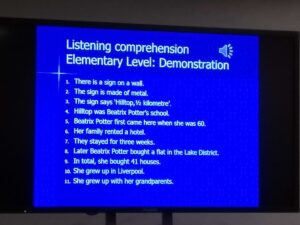
Sheila’s tried-and-trusted strategy is to regularly use audio materials in class. She lets her students listen to the recordings, work on the tasks and correct their own mistakes afterwards. Of course, she is there to help when they get stuck (also providing transcripts). She sees herself as a facilitator rather than a source of knowledge – which allows her students to acquire knowledge autonomously.
Self-correction is engaging for her learners, and they make good progress as a result.
Some advantages of authentic listening materials that Sheila mentioned were:
- understanding from context works well for students
- training listening comprehension is effective exam preparation
- real-life content is far more motivating than scripted materials
- not much preparation needed as the teacher can just show up with recordings and tasks
- content is easy to find on the internet
What’s more, the recordings don’t have to be long – all of the examples Sheila gave were under one minute (e.g. interview snippets). Authentic materials will also naturally bring up a wide range of ESL topics, including grammar, functional language, vocabulary, etc.

Throughout her talk, Sheila sprinkled in funny quips and anecdotes. She told us a story about a potential client whose English was so abysmal that she charged a horrendous fee for her services just to turn him away – but he came back anyway and she had to bite the bullet. Now, his English has improved dramatically and they are friends.
I thoroughly enjoyed this funny and inspiring farewell talk, which ended with a standing ovation from the audience and a visibly moved Sheila. I hope she’ll enjoy her golden years.
Brighton: worth a trip for sure!
Last but not least, another highlight for me was the “Introduction to Brighton”, a virtual walk through the city. The presentation was hosted by a local tour organiser and included little visuals and plenty of storytelling. It was fun to explore the history of Brighton, from the early beginnings as a small, sleepy fishing village to becoming the first seaside spa resort before turning into the cultural hotspot it is today.

I took a bit of time to explore some of the local attractions before merrily getting on my way back home, filled with gratefulness for the things I had learned and the connections and happy memories I had made.
I’m very much looking forward to seeing some of the inspiring speakers I discovered at future ELTABB workshops!
***
Sandra is ELTABB's Chair and the current editor of the ELTABB journal. She holds an MA in English and is passionate about brain-friendly language learning and teaching. Likes Shakespeare and Venetian lute music.


